Milwaukee Hammer Drill User Manual
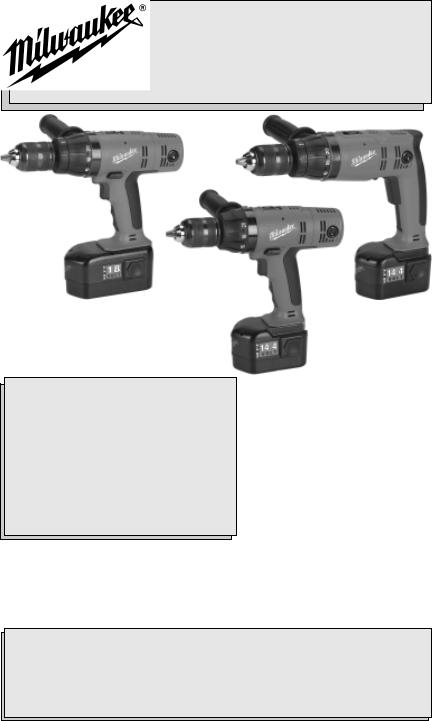
OPERATOR'S MANUAL MANUEL de L'UTILISATEUR MANUAL del OPERADOR
To extend battery pack life:
•Follow the "BATTERY PACK CARE AND USE" section of thismanual.
•Chargebatterypacksbeforeuse.
•Followthecharginginstructionsinyourchargermanual.
Pour étendre la durée de vie de la batterie:
•Suivre les instructions de la section «UTILISATION ET ENTRETIEN DE LA BATTERIE» de ce manuel.
•Chargerlesbatteriesavantdelesutiliser.
•Suivre les instructions de charge du manuel du chargeur.
Para extender la duración de la batería:
•Seguir la sección “USO Y CUIDADO DE LA BATERÍA” en estemanual.
•Cargarlasbateríasantesdeusarlas.
•Seguirlasinstruccionesdecargaenelmanualdelcargador.
Catalog No.
No de Cat.
Catálogo No.
0613-20 Lok-TorHammer-Drill
0614-20 Lok-TorHammer-Drill
0616-20 Lok-Tor Driver Drill
0622-20 Lok-Tor Driver Drill
0624-20 Lok-TorHammer-Drill
14.4 V AND 18 V LOK-TOR 1/2" HAMMER-DRILLS & DRIVER DRILLS
PERCEUSE À PERCUSSION ET PERCEUSE-VISSEUSE DE 14,4 V ET 18 V 13 mm (1/2") LOK-TOR
TALADRO DE PERCUSIÓN Y TALADRO ATORNILLADOR DE 13 mm (1/2") LOK-TOR Y 14,4 V Y 18 V
TO REDUCE THE RISK OF INJURY, USER MUST READ AND UNDERSTAND OPERATOR'S MANUAL.
AFIN DE RÉDUIRE LE RISQUE DE BLESSURES, L'UTILISATEUR DOIT LIRE ET BIEN COMPRENDRE LE MANUEL DE L'UTILISATEUR.
PARA REDUCIR EL RIESGO DE LESIONES, EL USUARIO DEBE LEER Y ENTENDER EL MANUAL DEL OPERADOR.


 GENERAL SAFETY RULES-FOR ALL BATTERY OPERATED TOOLS
GENERAL SAFETY RULES-FOR ALL BATTERY OPERATED TOOLS


 WARNING!
WARNING!
READALLINSTRUCTIONS
Failure to follow all instructions listed below may result in electric shock, fire and/or serious injury. The term "power tool" in all of the warnings listed below refers to your mains-operated (corded) power tool or batteryoperated (cordless) power tool.
SAVETHESEINSTRUCTIONS
WORK AREA SAFETY
1.Keep work area clean and well lit.
Cluttered or dark areas invite accidents.
2.Do not operate power tools in explosive atmospheres, such as in the presence of flammable liquids, gases, or dust. Power tools create sparks which may ignite the dust or fumes.
3.Keep children and bystanders away while operating a power tool. Distractions can cause you to lose control.
ELECTRICAL SAFETY
4.Power tool plugs must match the outlet. Never modify the plug in any way. Do not use any adapter plugs with earthed (grounded) power tools. Unmodified plugs and matching outlets will reduce risk of electric shock.
5.Avoid body contact with earthed or grounded surfaces such as pipes, radiators, ranges and refrigerators. There is an increased risk of electric shock if your body is earthed or grounded.
6.Do not expose power tools to rain or wet conditions. Water entering a power tool will increase the risk of electric shock.
7.Do not abuse the cord. Never use the cord for carrying, pulling, or unplugging the power tool. Keep cord away from heat, oil, sharp edges, or moving parts. Damaged or entangled cords increase the risk of electric shock.
8.When operating a power tool outdoors, use an extension cord suitable for outdoor use. Use of a cord suitable for outdoor use reduces the risk of electric shock.
PERSONAL SAFETY
9.Stay alert, watch what you are doing and use common sense when operating a power tool. Do not use a power tool while you are tired or under the influence of drugs, alcohol or medication. A moment of inattention while operating power tools may result in serious personal injury.
10.Use safety equipment. Always wear eye protection. Safety equipment such as dust mask, non-skid safety shoes, hard hat, or hearing protection used for appropriate conditions will reduce personal injuries.
11.Avoid accidental starting. Ensure the switch is in the off-position before plugging in. Carrying tools with your finger on the switch or plugging in power tools that have the switch on invites accidents.
12.Remove any adjusting key or wrench before turning the power tool on. A wrench or a key left attached to a rotating part of the power tool may result in personal injury.
13.Do not overreach. Keep proper footing and balance at all times.
This enables better control of the power tool in unexpected situations.
14.Dress properly. Do not wear loose clothing or jewellery. Keep your hair, clothing and gloves away from moving parts. Loose clothes, jewellery, or long hair can be caught in moving parts.
15.If devices are provided for the connection of dust extraction and collection facilities, ensure these are connected and properly used.
Use of these devices can reduce dustrelated hazards.

 POWER TOOL USE AND CARE
POWER TOOL USE AND CARE
16.Do not force the power tool. Use the correct power tool for your application. The correct power tool will do the job better and safer at the rate for which it was designed.
17.Do not use the power tool if the switch does not turn it on and off.
Any power tool that cannot be controlled with the switch is dangerous and must be repaired.
18.Disconnect the plug from the power source and/or the battery pack from the power tool before making any adjustments, changing accessories, or storing power tools. Such preventive safety measures reduce the risk of starting the tool accidentally.
19.Store idle power tools out of the reach of children and do not allow persons unfamiliar with the power tools or these instructions to operate power tools. Power tools are dangerous in the hands of untrained users.
20.Maintain power tools. Check for misalignment or binding of moving parts, breakage of parts and any other condition that may affect the power tool's operation. If damaged, have the power tool repaired before use. Many accidents are caused by poorly maintained power tools.
21.Keep cutting tools sharp and clean. Properly maintained cutting tools with sharp cutting edges are less likely to bind and are easier to control.
22.Use the power tool, accessories and tool bits etc., in accordance with these instructions and in the manner intended for the particular type of power tool, taking into account the working conditions and the work to be performed.
Use of the power tool for operations different from those intended could result in a hazardous situation.

 BATTERY TOOL USE AND CARE
BATTERY TOOL USE AND CARE
23.Ensure the switch is in the off position before inserting battery pack. Inserting the battery pack into power tools that have the switch on invites accidents.
24.Recharge only with the charger specified by the manufacturer. A charger that is suitable for one type of battery pack may create a risk of fire when used with another battery pack.
25.Use power tools only with specifically designated battery packs.
Use of any other battery packs may create a risk of injury and fire.
26.When battery pack is not in use, keep it away from other metal objects like paper clips, coins, keys, nails, screws, or other small metal objects that can make a connection from one terminal to another. Shorting the battery terminals together may cause burns or a fire.
27.Under abusive conditions, liquid may be ejected from the battery, avoid contact. If contact accidentally occurs, flush with water. If liquid contacts eyes, additionally seek medical help. Liquid ejected from the battery may cause irritation or burns.
SERVICE
28.Have your power tool serviced by a qualified repair person using only identical replacement parts.
This will ensure that the safety of the power tool is maintained.
2 |
3 |
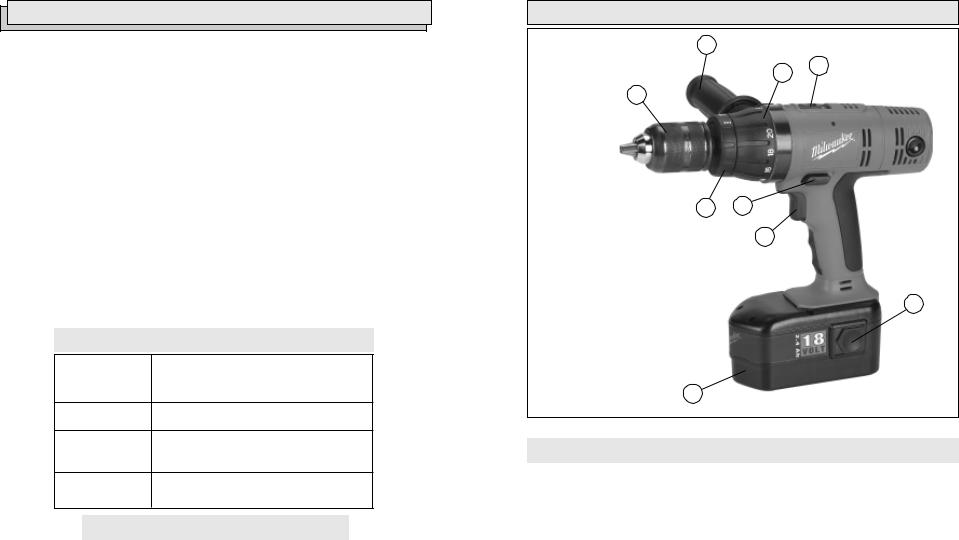
SPECIFICSAFETYRULES
1.Maintain labels and nameplates. These carry important information. If unreadable or missing, contact a MILWAUKEE service facility for a free replacement.
2.WARNING! Some dust created by power sanding, sawing, grinding, drilling, and other construction activities contains chemicals known to cause cancer, birth defects or other reproductive harm. Some examples of these chemicals are:
•lead from lead-based paint
•crystalline silica from bricks and cement and other masonry products, and
•arsenic and chromium from chemically-treated lumber.
Your risk from these exposures varies, depending on how often you do this type of work. To reduce your exposure to these chemicals: work in a well ventilated area, and work with approved safety equipment, such as those dust masks that are specially designed to filter out microscopic particles.
3.Use auxiliary handles supplied with the tool. Loss of control can cause personal injury.
4.Wear ear protectors with impact drills. Exposure to noise can cause hearing loss.
5.Hold power tools by insulated gripping surfaces when performing an operation where the cutting tool may contact hidden wiring or its own cord.
Contact with a “live” wire will make exposed metal parts of the tool “live” and shock the operator.
6.Keep hands away from all cutting edges and moving parts.
Symbology
Properly Recycle Nickel Cadmium Batteries
Direct Current
Underwriters Laboratories, Inc.
No Load Revolutions per Minute (RPM)
Specifications
|
|
|
No Load Blows |
Cat. No. |
Volts DC |
No Load RPM |
per Minute |
0613-20 |
14.4 |
Low 0-500 |
Low 0-7500 |
|
|
High 0-1700 |
High 0-25500 |
0614-20 |
14.4 |
Low 0-500 |
Low 0-7500 |
|
|
High 0-1700 |
High 0-25500 |
0616-20 |
14.4 |
Low 0-500 |
N/A |
|
|
High 0-1700 |
|
0622-20 |
18 |
Low 0-500 |
N/A |
|
|
High 0-1700 |
|
0624-20 |
18 |
Low 0-500 |
Low 0-7500 |
|
|
High 0-1700 |
High 0-25500 |
|
|
4 |
|
FUNCTIONALDESCRIPTION
8
1
9
7
1. Speed selector |
6 |
5 |
2.Battery latch
3. |
Battery pack |
4 |
|
||
4. |
Trigger |
|
5. |
Control switch |
|
6. |
Hammer/drill selector collar |
2 |
|
(Hammer-Drill models only) |
|
|
|
7.Keyless chuck
8.Side handle
9.Torque selector collar
3
Capacities
|
|
|
Wood |
|
|
|
|
|
Steel |
Flat Bit |
Auger Bit |
|
Hole Saw |
Screws |
Masonry |
|
|
(dia.) |
|||||
|
|
|
|
|
|
|
|
0613-20 |
1/2" |
1-1/2" |
1-1/8" |
|
2-1/8" |
1/4" |
3/8" |
0614-20 |
1/2" |
1-1/2" |
1-1/8" |
|
2-1/8" |
1/4" |
3/8" |
0616-20 |
1/2" |
1-1/2" |
1-1/8" |
|
2-1/8" |
1/4" |
N/A |
0622-20 |
1/2" |
1-1/2" |
1-1/8" |
|
2-1/8" |
1/4" |
N/A |
0624-20 |
1/2" |
1-1/2" |
1-1/8" |
|
2-1/8" |
1/4" |
3/8" |
|
|
|
|
|
|
|
|
5
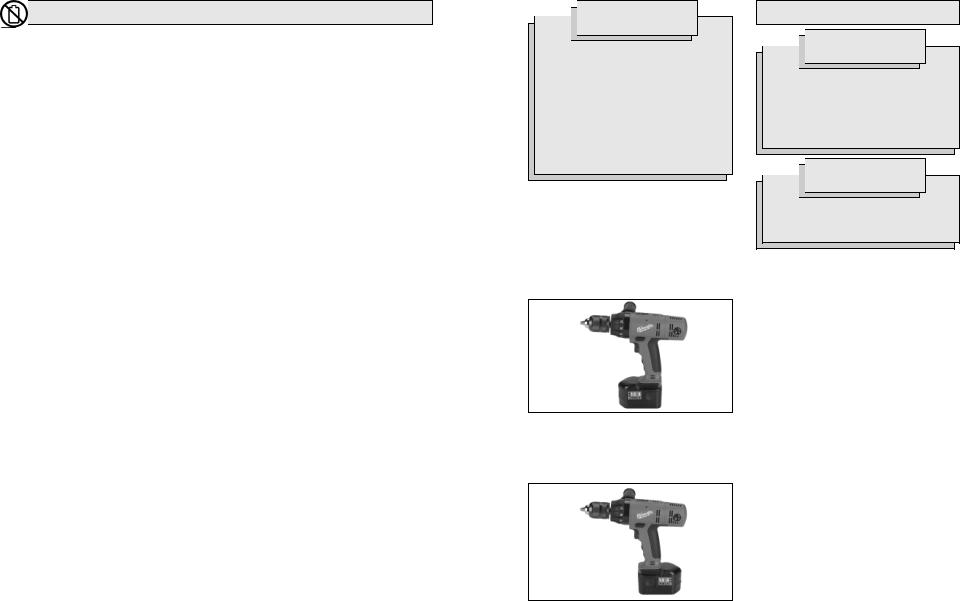
BATTERY PACK CARE AND USE
EXTENDING AND MAINTAINING
BATTERY PACK LIFE
MILWAUKEE battery packs will operate for many years and/or hundreds of cycles when they are used, charged, and stored according to these instructions. Properly using, charging, and storing your battery pack can greatly extend its life.
Charge the new battery pack overnight before use to allow the cells to become fully
charged. New battery packs are not fully charged. Two to ten normal charging/ discharging cycles may be required before the pack can take its maximum charge.
Never completely discharge the battery pack. MILWAUKEE battery packs do not develop a "memory" when charged after only a partial discharge. Taping-on triggers or leaving work lights on for extended periods to completely discharge the battery pack will reduce its life by upsetting the electrochemical balance and can result in short-
circuiting of the battery.
Do not charge batteries in hot or cold places (below 40°F (5°C) or above 105°F (40°C)). Temperature
extremes reduce the ability for battery pack cells to hold a charge. Do not store batteries where the temperature may exceed 120°F (50°C), such as in a vehicle or metal building during the summer.
To avoid overheating to a battery pack, allow cordless tools cool down between high torque drilling/cutting applications. The increased energy discharge rate will heat the battery pack cells faster than the cells can release the heat. This could damage the cells.
After use, allow a hot battery pack to cool to room temperature before inserting it into the charger. If a hot battery is put on a charger, charging will not begin until the battery has cooled to a safe temperature. See your charger manual for more information on charging temperatures. Charging a hot battery will damage the cells.
Never forcibly heat up or cool down batteries. This will damage some cells in the pack, causing them to not be able to hold a charge.
Remove the battery pack from the tool for charging when the tool can no longer perform its intended function
(i.e., drilling, cutting, etc.).
Leave the battery pack on the charger after it has reached a full charge; the pack will continue to receive a trickle charge to ensure capacity
is maintained.
Occasionally (once a week) leave the batteries on the charger overnight to help maintain cell balance.
Do not store the battery on the charger (for more than 24 hours); this could reduce battery life.
Never leave batteries on chargers where power interruptions are common. Damage to the battery cells could occur.
Store batteries at room temperature away from moisture.
Do not store in damp locations where corrosion of terminals may occur.
Do not submerge your battery or cordless tools in water. This will damage the battery and tool.
Charge unused batteries overnight at least every six months to maximize battery life. Unused batteries discharge at a rate of about 1% per day and will be fully discharged after six months. For batteries stored for a long time, two to ten normal charging cycles may be required before the pack is fully charged.
Do not use oil or solvents to clean or lubricate your battery pack. The plastic casing will become brittle and crack, causing a risk of injury.


 WARNING!
WARNING!
Charge only MILWAUKEE 12, 14.4 and 18 Volt battery packs in
MILWAUKEE chargers. Other brands of batteries may explode
causing personal injury and damage.
For specific charging instructions, please read the operator's manual supplied with your charger.
Inserting Battery Pack into Tool (Fig. 1 & 2)
The battery pack may feel warm after the charging cycle. If it is warm, maximize the output of the battery by allowing it to cool for a few minutes before inserting it into the tool.
Battery pack can be inserted into the tool in two ways.
Fig. 1
1.For working in restricted spaces.
Insert the battery pack from the front by sliding battery pack into the body of the tool. Insert the battery pack until the battery latches lock.
Fig. 2
2.For optimum weight distribution and balance.
Insert the battery pack from the back by sliding the battery pack into the body of the tool. Insert the battery pack until the battery latches lock.
3.To remove the battery pack, press in both battery latches and slide the battery pack off of the tool.
ASSEMBLY


 WARNING!
WARNING!
Always lock trigger or remove battery pack before changing or removing accessories. Only use accessories specifically recommended for this tool. Others may be hazardous.


 WARNING!
WARNING!
To reduce the risk of injury, always use a side handle when using this tool. Always brace or hold securely.
Installing the Side Handle
1.To install the side handle, loosen the side handle grip until the ring is large enough to slide over the torque selector collar. The raised rib on the side handle ring fits inside the groove around the tool. Rotate the handle to the desired position and tighten the side handle until it is secure.
2.To remove the side handle, loosen the side handle grip until the ring is large enough to slide off the tool.
6 |
7 |
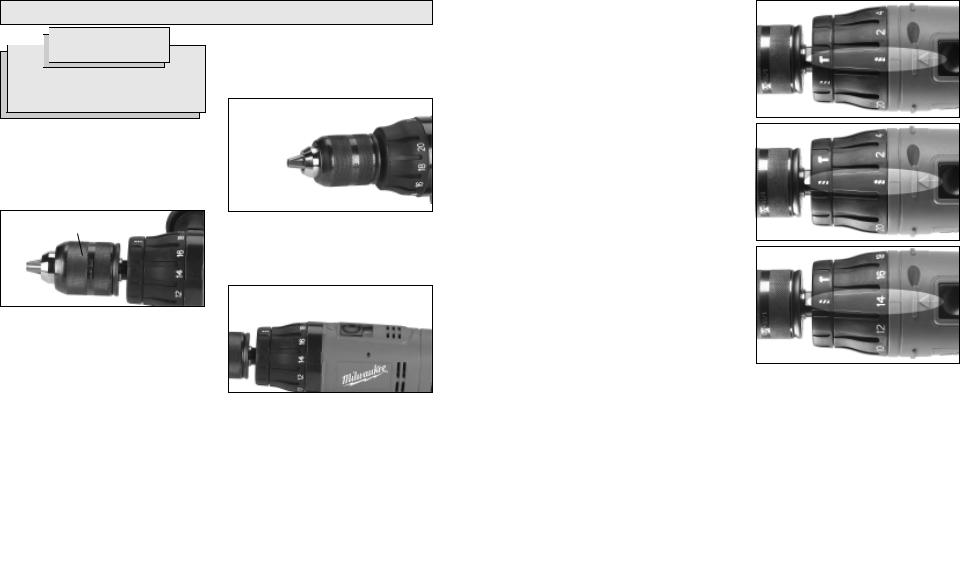
OPERATION


 WARNING!
WARNING!
To reduce the risk of injury, wear safety goggles or glasses with side shields.
Using Keyless Chucks (Fig. 3)
Your cordless tool is equipped with a spindle lock. The chuck can be tightened with one hand, creating higher grip strengths on the bit.
Always remove the battery pack or lock the trigger before inserting or removing bits.
Fig. 3 |
Sleeve |
|
1.To open the chuck jaws, turn the sleeve in the counterclockwise direction.
When using drill bits, allow the bit to strike the bottom of the chuck. Center the bit in the chuck jaws and lift it about 1/16" off of the bottom.
When using screwdriver bits, insert the bit far enough for the chuck jaws to grip the hex of the bit.
2.To close the chuck jaws, turn the sleeve in the clockwise direction. The bit is secure when the chuck makes a ratcheting sound and the sleeve can not be rotated any further.
3.To remove the bit, turn the sleeve in the counterclockwise direction.
NOTE: A ratcheting sound may be heard when the chuck is opened or closed. This noise is part of the locking feature, and does not indicate a problem with the chuck's operation.
Using Clutch (Fig. 4)
This tool has an adjustable clutch for driving different types of screws into different materials. When properly adjusted, the clutch will slip at a preset torque to prevent driving the screw too deep and to prevent damage to the screw or tool.
To adjust the clutch, turn the torque selector collar to one of the twenty positions shown on the collar. The number must line up with the arrow on top of the tool.
Fig. 4 Torque selector collar 
Position numbers 
The torque specifications shown here are approximate values obtained with a fully charged battery pack.
Selecting Speed (Fig. 5)
Fig. 5 |
Low |
High |
|
The speed selector is on top of the motor housing. Allow the tool to come to a complete stop before changing speeds. See “Applications” for recommended speeds under various conditions.
1.For Low speed (up to 500 RPM), push the speed selector forward.
2.For High speed (up to 1700 RPM), push the speed selector back.
Selecting Hammer or Drill Action (Cat.No.0613-20,0614-20,and0624-20only)
MILWAUKEE Hammer-Drills are designed for two operating modes: drilling with hammering action and drilling only. To set the operating mode, rotate the hammer/drill selector collar to the desired symbol. A drill or hammer symbol will appear in line with the arrow to indicate operating mode.
1.To use the hammer-drilling mode, rotate the hammer/drill selector collar
until the hammer symbol  appears in line with the arrow. Apply pressure to the bit to engage the hammering mechanism.
appears in line with the arrow. Apply pressure to the bit to engage the hammering mechanism.
2.To use the drilling only mode, rotate the hammer/drill selector collar until the drill symbol  appears in line with the arrow.
appears in line with the arrow.
NOTE: When using carbide bits, do not use water to settle dust. Do not attempt to drill through steel reinforcing rods. Both actions will damage the carbide bits.
Fig. 6
To Hammer
Fig. 7
To Drill
Fig. 8
To Drive Screws
Torque |
|
0614-20 |
|
|
|
|
0622-20 |
||
selector |
& 0616-20 |
|
0613-20 |
& 0624-20 |
|||||
collar setting |
|
Torque |
|
Torque |
|
Torque |
|||
1 - 5 |
0 - 17 in. lbs. |
0 - 17 in. lbs. |
0 - 17 in. lbs. |
||||||
|
|
|
|
|
|
|
|
|
|
6 - 10 |
21 |
- 38 |
in. lbs. |
21 |
- 38 |
in. lbs. |
21 |
- 38 |
in. lbs. |
|
|
|
|
|
|
|
|
|
|
11 - 15 |
42 |
- 60 |
in. lbs. |
42 |
- 60 |
in. lbs. |
42 |
- 60 |
in. lbs. |
|
|
|
|
|
|
|
|
|
|
16 - 20 |
65 |
- 85 |
in. lbs. |
65 |
- 85 |
in. lbs. |
65 |
- 85 |
in. lbs. |
|
|
|
|
|
|
|
|
|
|
Drill |
|
|
|
350 in. lbs |
|
|
|
||
Low |
460 in. lbs. |
495 in. lbs. |
|||||||
High |
160 in. lbs. |
120 in. lbs. |
175 in. lbs. |
||||||
|
|
|
|
|
|
|
|
|
|
NOTE: Because the above settings are only a guide, use a piece of scrap material to test the different clutch positions before driving screws into the workpiece.
8 |
9 |
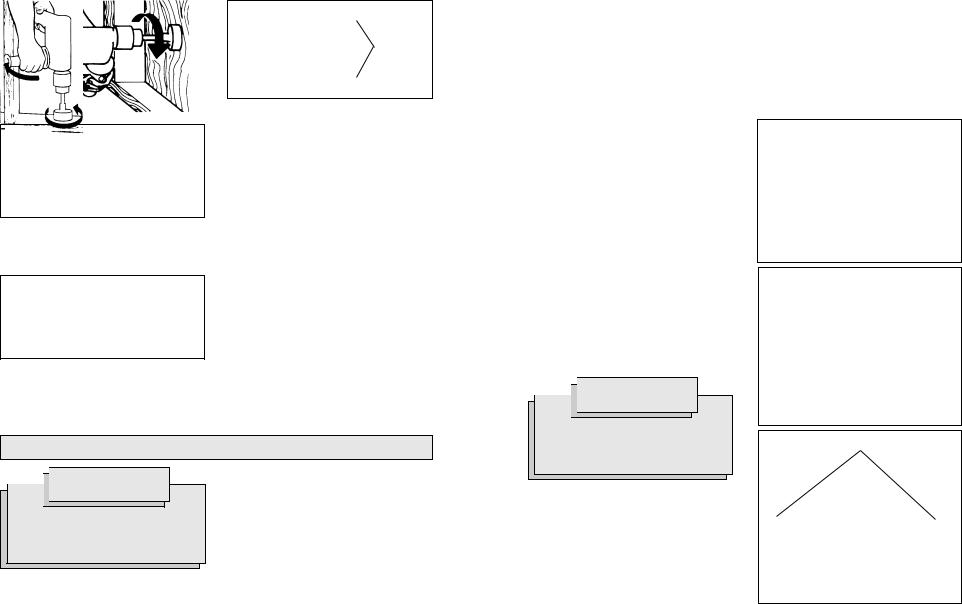
Using Control Switch (Fig. 9, 10, and 11)
The control switch may be set to three positions: forward, reverse and lock. Due to a lockout mechanism, the control switch can only be adjusted when the ON/OFF switch is not depressed. Always allow the motor to come to a complete stop before using the control switch.
For forward (clockwise) rotation, push in the control switch from the right side of the tool (Fig. 9). Check the direction of rotation before use.
Fig. 9
 Push in for forward
Push in for forward
For reverse (counterclockwise) rotation, push in the control switch from the left side of the tool (Fig. 10). Check direction of rotation before use.
Fig. 10
Push in  for reverse
for reverse
To lock the trigger, push the control switch to the center position (Fig. 11). The trigger will not work while the control switch is in the center locked position. Always lock the trigger or remove the battery pack before
performing maintenance, changing accessories, storing the tool and any time the tool is not in use.
Fig. 11
Push to center position to lock trigger
Starting, Stopping & Controlling Speed
1.To start the tool, pull the trigger.
2.To stop the tool, release the trigger and an electric brake stops the tool instantly.
All models feature variable speed control. To vary the speed, simply increase or decrease pressure on the trigger. The further the trigger is pulled, the greater the speed.
Drilling
Set both the hammer/drill and torque selector collars to the drill positions.
Place the bit on the work surface and apply firm pressure before starting. Too much pressure will slow the bit and reduce drilling efficiency. Too little pressure will cause the bit to slide over the work area and dull the point of the bit.
If the tool begins to stall, reduce pressure slightly to allow the bit to regain speed. If the bit binds, reverse the motor to free the bit from the workpiece.
APPLICATIONS


 WARNING!
WARNING!
To reduce the risk of electric shock, check work area for hidden pipes and wires before drilling or driving screws.
the hole frequently to clear chips from the bit flutes. To reduce the chance of splintering, back work with a piece of scrap wood. Select low speeds for plastics with a low melting point.
Drilling in Metal
Drilling in Wood, Composition Materials and Plastic
When drilling in wood, composition materials and plastic, start the drill slowly, gradually increasing speed as you drill. When drilling into wood, use wood augers or twist drill bits. Always use sharp bits. When using twist drill bits, pull the bit out of
When drilling in metal, use high speed steel twist drills or hole saws. Use a center punch to start the hole. Lubricate drill bits with cutting oil when drilling in iron or steel. Use a coolant when drilling in nonferrous metals such as copper, brass or aluminum. Back the material to prevent binding and distortion on breakthrough.
Drilling in Masonry
When drilling in masonry, select the hammer-drill operating mode (Cat. No. 0613-20, 0614-20, and 0624-20 only). Use high speed carbide-tipped bits. Drilling soft masonry materials such as cinder block requires little pressure. Hard materials like concrete require more pressure. A smooth, even flow of dust indicates the proper drilling rate. Do not let the bit spin in the hole without cutting. Do not use water to settle dust or to cool bit. Both actions will damage the carbide.
Driving Screws and Nut Running
Drill a pilot hole when driving screws into thick or hard materials. Set the torque selector collar to the proper position and set the speed to low. Use the proper style and size screwdriver bit for the type of screw you are using.
With the screwdriver bit in the screw, place the tip of the screw on the workpiece and apply firm pressure before pulling the trigger. Screws can be removed by reversing the motor.
Overloading
Continuous overloading may cause permanent damage to tool or battery pack.


 WARNING!
WARNING!
High rotational force. To reduce the risk of injury, always hold or brace securely. Always use side handle on tools.
Bit Binding
A high rotational force occurs when a bit binds. If the bit binds, the tool will be forced in the opposite direction of the bit rotation. Bits may bind if they are misaligned or when they are breaking through a hole. Wood boring bits can also bind if they run into nails or knots. Be prepared for bit binding situations.
To reduce the chance of bit binding:
•Use sharp bits. Sharp bits are less likely to bind when drilling.
•Use the proper bit for the job. There are bits that are designed for specific purposes.
•Use caution when drilling pitchy, knotty, wet or warped material or when drilling in material that may contain nails.
Typical Bracing Methods
Fig. 12 |
Forward rotation |
Reaction
Bracing against the floor
Fig. 13
Forward rotation
Reaction
Bracing against your leg
Fig. 14 |
Reaction |
|
|
||
Reverse rotation |
Forward rotation |
|
|
Bracing against a stud |
|
10 |
11 |

MAINTENANCE


 WARNING!
WARNING!
To reduce the risk of personal injury, always unplug the charger and remove the battery pack from the charger or tool before performing any maintenance. Never disassemble the tool, battery pack or charger. Contact a
MILWAUKEE service facility for ALL repairs.
Maintaining Tool
Keep your tool, battery pack and charger in good repair by adopting a regular maintenance program. After six months to one year, depending on use, return the tool, battery pack and charger to a MILWAUKEE service facility for:
•Lubrication
•Brush inspection and replacement
•Mechanical inspection and cleaning (gears, spindles, bearings, housing, etc.)
•Electrical inspection (battery pack, charger, motor)
•Testing to assure proper mechanical and electrical operation
If the tool does not start or operate at full power with a fully charged battery pack, clean the contacts on the battery pack. If the tool still does not work properly, return the tool, charger and battery pack to a MILWAUKEE service facility for repairs.
Maintaining Battery Pack
MILWAUKEE battery packs will operate for many years and/or hundreds of cycles when they are maintained and used according to these instructions.
A battery pack that is stored for six months without being used will discharge itself. Batteries discharge at a rate of about 1% per day. Charge the battery every six months even if it is unused to maximize battery life. Do not tape the trigger in the “ON” position and leave the tool unattended as this may discharge the battery to a point where it will no longer be able to recharge. Use a MILWAUKEE battery pack only until it no longer performs with the power and torque needed for your application.
Store your battery pack in a cool, dry place. Do not store it where the temperature may exceed 120°F (50°C) such as in a vehicle or metal building during the summer. High temperatures will overheat the battery pack, reducing battery life. If it is stored for several months, the battery pack will gradually lose its charge. One to three cycles of charging and discharging through normal use will restore the capacity of the battery pack. During the life of the battery pack, the operating time between charges becomes shorter. If the operating time becomes extremely short after a proper charge, the usable life of the battery pack has been reached and it should be replaced.


 WARNING!
WARNING!
To reduce the risk of personal injury and damage, never immerse your tool, battery pack or charger in liquid or allow a liquid to flow inside them.
Cleaning
Clean dust and debris from charger and tool vents. Keep tool handles clean, dry and free of oil or grease. Use only mild soap and a damp cloth to clean the tool, battery pack and charger since certain cleaning agents and solvents are harmful to plastics and other insulated parts. Some of these include gasoline, turpentine, lacquer thinner, paint thinner, chlorinated cleaning solvents, ammonia and household detergents containing ammonia. Never use flammable or combustible solvents around tools.


 WARNING!
WARNING!
To reduce the risk of explosion, never burn a battery pack even if it is damaged, dead or completely discharged.
RBRC Battery Recycling Seals
The RBRC™ Battery Recycling Seals (see "Symbology") on your tool battery packs indicate that MILWAUKEE has arranged for the recycling of that battery pack with the
Rechargeable Battery Recycling Corporation (RBRC). At the end of your battery pack's useful life, return the battery pack to a MILWAUKEE Branch Office/Service Center or the participating retailer nearest you. For more information, visit the RBRC web site at www.rbrc.org.
Disposing of Nickel-Cadmium Battery Packs
Nickel-Cadmium battery packs are recyclable. Under various state and local laws, it may be illegal to dispose of this battery into the municipal waste stream. Dispose of your battery pack according to federal, state and local regulations.
Repairs
For repairs, return the tool, battery pack and charger to the nearest service center listed on the back cover of this operator's manual.
Battery Pack Warranty
Battery packs for cordless tools are warranted for one year from the date of purchase.
FIVE YEAR TOOL
LIMITED WARRANTY
Every MILWAUKEE tool is tested before leaving the factory and is warranted to be free from defects in material and workmanship. MILWAUKEE will repair or replace (at MILWAUKEE’s discretion), without charge, any tool (including battery chargers) which examination proves to be defective in material or workmanship from five (5) years after the date of purchase. Return the tool and a copy of the purchase receipt or other proof of purchase to a MILWAUKEE Factory Service/Sales Support Branch location or MILWAUKEE Authorized Service Station, freight prepaid and insured. This warranty does not cover damage from repairs made or attempted by other than MILWAUKEE authorized personnel, abuse, normal wear and tear, lack of maintenance, or accidents.
Battery Packs, Flashlights, and Radios are warranted for one (1) year from the date of purchase.
THEREPAIRANDREPLACEMENTREMEDIES DESCRIBEDHEREINAREEXCLUSIVE.INNO EVENT SHALL MILWAUKEE BE LIABLE FOR ANY INCIDENTAL, SPECIAL, OR CONSEQUENTIAL DAMAGES, INCLUDING LOSS OF PROFITS.
THIS WARRANTY IS EXCLUSIVE AND IN LIEU OF ALL OTHER WARRANTIES, OR CONDITIONS, WRITTEN OR ORAL, EXPRESSED OR IMPLIED FOR MERCHANTABLILITY OR FITNESS FOR PARTICULAR USE OR PURPOSE.
This warranty gives you specific legal rights. You may also have other rights that vary from state to state and province to province. In those states that do not allow the exclusion of implied warranties or limitation of incidental or consequential damages, the above limitations or exclusions may not apply to you. This warranty applies to the United States, Canada, and Mexico only.
12 |
13 |
